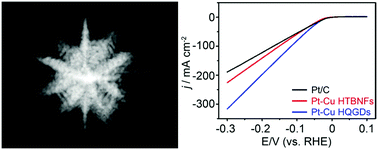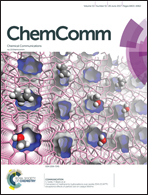Pt–Cu hierarchical quasi great dodecahedrons with abundant twinning defects for hydrogen evolution†
Abstract
Hierarchical metal nanostructures which exhibit an open structure and a high density of twin defects accessible to reactants hold great promise in catalysis. Here, we report a facile synthesis of Pt–Cu hierarchical quasi great dodecahedrons (HQGDs) which present 5-fold symmetry and are composed of multiple ordered branched units with a frame structure. HQGDs evolve from icosahedral seeds with multiple {111} twin planes, followed by the growth of higher-order branches. Owing to the unique frame structure associated with multiple twin defects, HQGDs showed much higher HER catalytic activity and better durability relative to commercial Pt/C.



 Please wait while we load your content...
Please wait while we load your content...